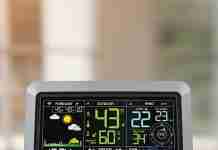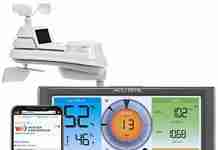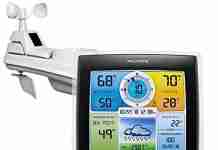Let’s discuss the drawbacks of using an automatic weather station. With the advancement of technology, these stations have become widely used for gathering accurate weather data. However, like any system, they do have their limitations.
From potential instrument errors to the need for regular maintenance and the possibility of data loss, there are several factors to consider when relying on automatic weather stations.
In this article, we will explore some disadvantages of using these stations and how they can impact the accuracy and reliability of weather forecasts and analysis.
Review contents
1. Cost
1.1 Initial Investment
When considering the purchase of an automatic weather station (AWS), one of the first factors to consider is the initial investment cost. AWS systems can be pretty pricey, especially if you opt for high-quality, reliable equipment.
The price will vary depending on the specific requirements and features of the AWS, such as the number and type of sensors, data transmission capabilities, and additional accessories. While investing in a quality AWS system is essential to ensure accurate and reliable weather data, the upfront cost can be a significant barrier for some users.
1.2 Maintenance and Repairs
Apart from the initial investment, it is essential to consider the ongoing maintenance and repair costs associated with an automatic weather station. Weather monitoring equipment can be delicate and prone to damage, especially in harsh weather conditions. Routine maintenance and periodic calibration are necessary to ensure accurate data collection.
Additionally, repairs or replacements may be required in the event of a malfunction or component failure. These maintenance and repair costs can add up over time, making it essential to budget for such expenses when considering the purchase of an AWS.
2. Reliability and Accuracy
2.1 Dependency on Power Source
One of the potential drawbacks of an automatic weather station is its dependency on a reliable power source. Without a constant power supply, the AWS may not be able to function correctly, leading to gaps in data collection or even a complete shutdown of the system.
This dependence on a power source can be a concern, particularly in remote or off-grid locations where a consistent power supply may not be readily available. Backup power systems or alternative energy sources may need to be implemented to ensure continuous operation of the AWS.
2.2 Sensor Malfunctions
Another disadvantage of automatic weather stations is the possibility of sensor malfunctions. Sensors are crucial in accurately measuring weather parameters such as temperature, humidity, wind speed, and precipitation. However, sensors can deteriorate over time or be affected by external factors such as dust, moisture, or extreme temperatures.
If a sensor malfunctions or provides inaccurate readings, it can significantly impact the reliability and accuracy of the weather data collected by the AWS. Regular sensor maintenance and periodic calibration are essential to minimize the risk of malfunction and ensure accurate measurements.
2.3 Limited Data Collection
While automatic weather stations can collect a wide range of weather data, there are certain limitations to the extent of data collection. AWS systems typically record basic meteorological parameters like temperature, humidity, wind speed, and precipitation.
However, more specialized data such as atmospheric pressure, solar radiation, or air quality may not be readily available from standard AWS setups. If specific data beyond the basic parameters is required, additional equipment or sensors may need to be incorporated into the system, resulting in additional costs and complexities.
3. Environmental Limitations
3.1 Vulnerability to Extreme Weather
Although automatic weather stations are designed to withstand various weather conditions, they still have vulnerabilities, particularly when exposed to extreme weather events. High winds, heavy rainfall, hail, or lightning strikes can potentially damage the structure, sensors, or other components of the AWS. Extreme temperatures can also affect the performance and accuracy of the sensors, leading to unreliable data. It is crucial to consider the local climate and environmental conditions when installing an AWS and take appropriate measures to protect it from potential damage.
3.2 Potential for Damage
In addition to extreme weather, there is also a risk of damage to the automatic weather station from other environmental factors. For instance, exposure to corrosive environments, such as coastal areas with high salt content in the air, can accelerate the wear and tear of the equipment. Similarly, vegetation or wildlife near the AWS can pose a risk of physical damage or interference with the sensors. Regular inspections and maintenance are necessary to identify and address any potential sources of damage to ensure the longevity and reliable operation of the AWS.
4. Calibration and Calibration Maintenance
4.1 Calibration Requirements
Automatic weather stations need to be calibrated regularly to ensure accurate weather data. Calibration involves comparing the readings from the AWS sensors with a reference instrument to determine and correct any systematic errors. Calibration requirements may vary depending on the specific sensors and equipment used in the AWS setup. Factors such as temperature, humidity, and exposure to environmental conditions can impact the calibration stability over time. It is essential to follow the manufacturer’s guidelines and schedule periodic calibrations to maintain the accuracy of the collected data.
4.2 Frequency of Calibration
The calibration frequency is an important consideration when operating an automatic weather station. Depending on the specific requirements and regulations, sensors may need to be calibrated annually, semi-annually, or more frequently. Regular calibration ensures that the AWS maintains its accuracy and reliability over time. However, frequent calibration can be time-consuming and may require professional assistance. Moreover, the additional costs associated with calibration services and potential downtime during calibration should be considered when considering using AWS.
5. Data Compatibility and Accessibility
5.1 Data Format Compatibility
Automatic weather stations generate data in specific formats, which may not be compatible with all data analysis or visualization tools. Depending on the chosen AWS system and manufacturer, the data output may vary in format, structure, or data variables.
Incompatibility issues can arise when integrating AWS data with existing data management systems or when attempting to share data with other organizations or researchers. Data format conversion or specialized software may be required to ensure seamless integration and compatibility of the AWS data with other systems.
5.2 Data Accessibility
While AWS systems provide a significant amount of weather data, the accessibility and ease of retrieving the data can vary. Some AWS setups may offer limited options for data retrieval, requiring manual downloads or access through specific software interfaces. This can disadvantage users who need real-time or frequent access to the weather data. It is essential to consider the data accessibility options provided by the AWS system, including data storage capacity, remote access capabilities, and compatibility with data management systems.
6. Communication and Data Transmission
6.1 Data Transmission Interference
Automatic weather stations rely on communication systems to transmit data from the sensors to a centralized storage or analysis platform. However, various sources of interference can affect data transmission. For example, physical obstacles like buildings or terrain features may block or weaken wireless signals, resulting in data loss or delays.
Electromagnetic interference from other nearby electronic devices or structures can also disrupt the data transmission process. Ensuring a reliable and uninterrupted data transmission can be challenging, especially in areas with limited network coverage or high interference levels.
6.2 Network Connection Issues
Dependence on network connectivity is another factor that can impact the functionality of an automatic weather station. If the AWS relies on a specific network infrastructure or internet connection, any disruptions in the network can hinder data transmission and accessibility.
Maintaining a stable and reliable network connection for the AWS can pose challenges in remote or rural areas with limited network coverage. Backup communication systems or alternative data transmission methods may be necessary to ensure continuous data flow from the AWS.
7. Limited Customization and Flexibility
7.1 Inability to Add or Modify Sensors
Automatic weather station setups often come with pre-determined sensors and configurations that may not be customizable or easily adaptable. This limitation can be a drawback for users who require specific sensors or want to expand the capabilities of the AWS over time.
In some cases, investing in additional equipment or replacing the entire AWS system may be necessary to accommodate new sensor requirements. The lack of flexibility in adding or modifying sensors can restrict the adaptability and scalability of the AWS, potentially resulting in additional costs and limitations in data collection.
7.2 Lack of Adaptability to Different Environments
Automatic weather stations may not be suitable for all environments or climatic conditions. Each AWS system has operational limitations based on temperature range, relative humidity levels, or specific weather conditions. Extreme cold or hot environments can affect the performance and accuracy of the sensors, leading to unreliable data.
Additionally, specific environmental requirements, such as mounting options or sensor protection measures, may not be adaptable to particular locations. It is crucial to carefully consider the suitability of the AWS system for the intended environment to avoid limitations and potential inaccuracies in the weather data collected.
8. Security and Cybersecurity Risks
8.1 Vulnerability to Hacking
As with any network-connected device, automatic weather stations are vulnerable to hacking and unauthorized access. Breaches in the security of an AWS system can result in tampering with collected data, disruption of data transmission, or even control of the entire station.
Cybersecurity measures, such as secure network protocols, encryption, and regular software updates, must be implemented to prevent unauthorized access and protect the integrity of the weather data. It is essential to stay informed about the latest security threats and best practices to ensure the safety and reliability of the AWS system.
8.2 Data Breach Risks
Automatic weather stations collect and store vast amounts of data, including potentially sensitive information such as location data or user details. Data breaches can expose this information to unauthorized parties, leading to privacy concerns and potential data misuse.
Proper data encryption, secure storage protocols, and access controls are necessary to mitigate the risk of data breaches. Regular security audits, compliance with data protection regulations, and education for users and operators can help minimize the chances of data breaches and protect the privacy of collected weather data.
9. Limited User Control and Interaction
9.1 Inability to Adjust Settings Remotely
One of the drawbacks of automatic weather stations is the limited control and adjustment options available to users. Fine-tuning or modifying specific settings, such as sampling rates, data transmission intervals, or alarm thresholds, may require direct physical access to the AWS equipment.
This lack of remote control can be impractical, especially when the AWS is installed in hard-to-reach or hazardous locations. In such cases, any necessary adjustments or customizations may require additional field visits or manual intervention, resulting in increased operational costs and limitations in real-time monitoring.
9.2 Limited User Interface
The user interface of an automatic weather station can vary depending on the manufacturer and model. Some AWS systems may have simplistic interfaces with limited customization options or flexibility in data visualization and analysis.
This can make it challenging for users to interact with and interpret the collected weather data effectively. User-friendly interfaces with intuitive navigation, customizable display options, and tools for data analysis are essential for maximizing the usability and user experience of the AWS system.
10. Dependency on External Factors
10.1 Reliance on Meteorological Services
While automatic weather stations provide valuable weather data, they often rely on external meteorological services for specific parameters or data validation. For example, AWS systems may require reference data from regional weather stations or meteorological models to verify the accuracy of their measurements. The availability and quality of these external data sources can impact the reliability and completeness of the weather data provided by the AWS. The dependency on external sources can introduce uncertainties and delays in data processing and analysis.
10.2 Connection to External Data Sources
In addition to relying on meteorological services, automatic weather stations may require connections to other external data sources for specific applications or data integration purposes.
For instance, integrating weather data with other environmental or agricultural databases may be necessary for comprehensive analysis or decision-making processes. However, establishing and maintaining these connections can be complex and time-consuming.
Compatibility issues, varying data formats, or changes in data sources can create challenges in managing connections with external data sources, potentially impacting the richness and accuracy of the collected weather data.



































